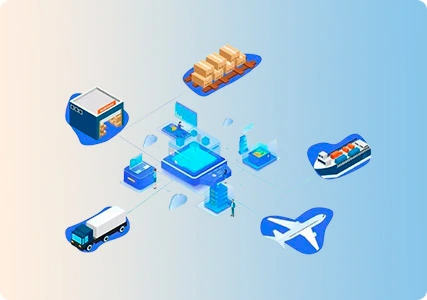The chain of cross-border logistics can be divided into: front-end collection, warehouse operation, export customs declaration, trunk movement, customs clearance, transfer and distribution, last-mile delivery, returns, etc. First-leg transportation refers to the transportation process in which merchants transport commodities to overseas warehouses through trunk transportation or combined transportation; tail-haul transportation refers to the transportation process in which commodities arrive overseas and are delivered to final consumers.
End-to-end optimization from the first mile to the last mile is essential to achieving meaningful cost reductions in any supply chain, according to eTower logistics expert: "By streamlining order collaboration, communication, and transportation management, companies can determine the most efficient and cost-effective way to move goods through the complex first mile of the supply chain. From reducing costs by an average of 10% to meeting environmental targets for reducing emissions, the immediate benefits are clear; and the overall value is undeniable as the vision of end-to-end supply chain visibility, standardization and optimization can become a reality".
The movement of goods from a centralized warehouse or storage facility to a centralized distribution center or shipping hub is referred to as first-mile delivery. From there, a logistics partner, freight forwarder, or carrier moves the goods to the next stage of the shipping process.
For example, the logistics between sellers sending products to Amazon's FBA warehouses is usually called FBA first-leg logistics.
The common first leg transportation methods are:
For international express delivery, the most commonly used and practical logistics channel for most sellers is the most expensive. It is more suitable for those customers who want promote new product or their shipment volume is relatively small. Except international express delivery, here are also three common ways used in first leg transportation.
1. Air transport
Air freight refers to a logistics mode in which the freight forwarder directly transports the goods to the destination country by air through its own channels, and then the freight forwarder's cooperative delivery agency in the destination country delivers the goods on its behalf. If the first flight of FBA is carried by air, the cost will be more expensive, and there is a fixed flight time. From a security point of view, it is relatively safe for FBA to travel by air for the first time.
2. Shipping by sea
Compared with air freight, sea freight is much cheaper, so many Amazon sellers like to use sea freight. However, shipping by sea will be affected by natural weather and other aspects in terms of logistics timeliness, resulting in very long transportation time.
3. International Express
Compared with sea and air freight, international express delivery has the shortest transportation time, and some can reach Europe in only one week. For example, UPS sends red orders or DHL, the time limit is very fast, but the price varies according to different logistics providers. When choosing express delivery, pay attention to the ability to clear customs.
The Importance of Optimizing the First Mile
First mile optimization can bring a great deal of added value, such as
Faster response times ensure that shipping managers can respond quickly to new orders and maintain a competitive edge by offering a full range of shipping services.
Real-time shipment tracking is one of several visualization tools used to monitor shipments across all delivery modes, helping to meet the needs of both customers and carriers.
Reduced resource wastage and continuous route optimization maximize the use of service time constraints while reducing fuel wastage and ineffective transportation miles.
Efficient document management provides drivers and customers with automated tools to sign and record necessary documents quickly, easily and securely.
Optimized shipping routes eliminate delivery delays due to traffic conditions, inclement weather and last-minute schedule changes.
Improve collaboration opportunities by using an integrated transportation management system that provides real-time shipment status.
Precautions in First-Leg Transportation
1. When the seller chooses the FBA first-leg transportation method, he needs to take both timeliness and his own capital turnover into consideration to reduce costs.
2. Second, the seller should also consider the weight of the product when selecting the product. If the volume of the goods is large, it is necessary to consider the delivery method combined with the heavier goods to avoid the extra freight caused by the oversized goods.
3. It is recommended to use multiple transportation methods as much as possible to ensure that your products are in stock, which can continuously bring you income and profits and reduce transportation costs.
4. Before sending the FBA head trip, the seller must understand the policies and barriers of the country where the selected FBA warehouse is located, and make full preparations for the first leg transportation.
E-commerce First Mile Logistics Challenges
Managing the first mile of e-commerce logistics often presents several stumbling blocks. Each of these issues can potentially cause significant problems and delays.
Labeling - Every item shipped, regardless of mode, must be properly labeled and identified to ensure proper shipping and handling.
Packaging - Without proper packaging, items can be damaged or lost during loading or in transit.
Inventory - Effective inventory management and the use of accurate packing lists can help ensure minimal delays in order fulfillment and loading. This is a great first step toward achieving the goal of on-time, full shipments.
Congestion - Accurate scheduling at docks, ports, and trucking yards is critical to ensuring a smooth and easy shipment that avoids costly delays.
Shipment Data Handling - All shipment data must be accurate, including critical information such as the number of items in an order, weight, size, and final destination.
Documentation - Some shipments require permits, licenses, or other documentation and paperwork to allow certain materials to cross state or national borders.
First Leg Transportation system
In the first leg transportation, choosing a professional and easy-to-use transportation management software can yield twice the result with half the effort!
eTower logistics collaboration system is an efficient logistics SaaS system tailored for cross-border logistics enterprises. It integrates multi-platform order management, multi-terminal application, whole-process route visualization, and paperless financial management.
The system can run through the first journey and the overseas last journey, allowing orders to be circulated in one system. Customers can operate and track the status of goods in transit on the system in a data-based and transparent manner.
If you want to know more information and other applications, welcome to contact us, please visit our website at https://www.etowertech.com/ . We will be happy to help you out!










